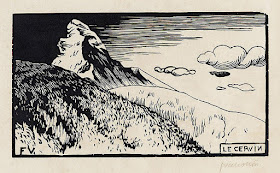FELIX VALOTTON (1865-1925)
Cervin / Matterhorn (4,478m -14,691ft)
Switzerland - Italy border
Switzerland - Italy border
About the work
Those very famous woodcuts and illustrations in black and white brings to the young Swiss painter Felix Valotton an international fame. In 1891, he literally renewed the art of xylography following the publication of an article by Albert Aurier, "Le Symbolisme en peinture", calling for an "idealistic" and decorative art, from which would be banished "Concrete truth, illusionism, trompe-l'oeil". The engravings that Valotton show in 1892 made such a sensation that he was invited to take part in various shows (Salon des artistes français, Salon des indépendants, Salon d'automne).
In the begining of 1892 Valotton engraved on wood a series of mountains from the French and Swiss Alps, which he exhibited at the first Salon de la Rose-Croix in 1892. They were immediately noticed by the Nabis, a group he rallied from 1893 to 1903 before making a long friendship with Édouard Vuillard.
The mountain
The Mont Cervin (4,478m -14,691ft) also known as the Matterhorn is an alpine summit located on the Swiss-Italian border between the canton of Valais and the Aosta Valley in Switzerland. It has several other names: Cervino in Italian, Grand'Bèca in Arpitan, Matterhorn in German. The Cervin / Matterhorn is the most famous mountain in Switzerland, including the pyramidal shape that it offers from the village of Zermatt, in the German-speaking part of the canton of Valais.
Its four sides are joined about 400 meters below the summit in a summit pyramid, called "roof." Its summit is a broad ridge about two meters, on which stand actually two summits: one called "Swiss summit," the farther east, and the "Italian summit" slightly lower (4,476 meters), on the west side of the ridge. The two are separated by a notch in the hollow of which a cross was laid in September 1901.
Félix Edouard Vallotton was a Swiss/French painter and printmaker associated (from 1892) with Les Nabis, a group of young artists that included Pierre Bonnard, Ker-Xavier Roussel, Maurice Denis, and Edouard Vuillard, with whom Vallotton was to form a lifelong friendship. During the 1890s, when Vallotton was closely allied with the avant-garde, his paintings reflected the style of his woodcuts, with flat areas of color, hard edges, and simplification of detail. His subjects included genre scenes, portraits and nudes. Examples of his Nabi style are the deliberately awkward Bathers on a Summer Evening (1892–93), now in the Kunsthaus Zurich, and the symbolist Moonlight (1895), in the Musée d'Orsay, Paris.
Vallotton's paintings of the post-Nabi period found admirers, and were generally respected for their truthfulness and their technical qualities, but the severity of his style was frequently criticized. Typical is the reaction of the critic who, writing in the March 23, 1910 issue of Neue Zurcher Zeitung, complained that Vallotton "paints like a policeman, like someone whose job it is to catch forms and colors. Everything creaks with an intolerable dryness ... the colors lack all joyfulness."
In its uncompromising character his art prefigured the New Objectivity that flourished in Germany during the 1920s, and has a further parallel in the work of Edward Hopper.
_______________________________
2018 - Wandering Vertexes...
by Francis Rousseau
_______________________________
2018 - Wandering Vertexes...
by Francis Rousseau
